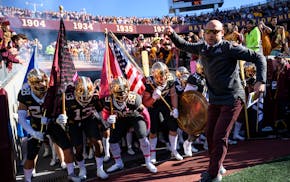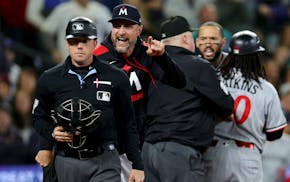We know that the Big Ten will not have a fall football season, a decision made Tuesday when the conference canceled play in all of its fall sports because of the coronavirus pandemic. And we know that the conference is exploring the possibility of playing a spring football season in 2021.
What we don't know is what that spring season might look like, and frankly, neither do Big Ten administrators, athletic directors and coaches at this point.
"We've been talking about various scenarios, and we'll start focusing on what we can do," Big Ten Commissioner Kevin Warren said. Gophers athletic director Mark Coyle said more "robust conversations" on what a spring season might look like will happen in the next few weeks.
There are doubters about the Big Ten's ability to pull off a spring season — "No chance," former Ohio State coach Urban Meyer told Big Ten Network on Tuesday, citing the toll on the players participating in a spring season followed by a fall season. And there are those who want to make a spring season work. "We've got find a way to play in the spring," Purdue coach Jeff Brohm told BTN, "and I'm all for that."
For spring football to happen amid COVID-19, several questions must be answered. Here are some of those:
When would the spring season be played?
There have been several ideas floated, and among those is a 10-game season beginning March 13 and running through May 15, with a Big Ten championship game to follow. Others call for a mid-March start, but a six- or seven-game season, with division-only play and possibly one crossover game.
Ohio State coach Ryan Day favors more of a winter start than a spring one.
"Starting the first week of January would be the best way to go and [have] an eight-week season," Day said in a video news conference. His Buckeyes are coming off a 13-1 season and had national championship aspirations.
Day's motivation for the January start is a nod to both a roster full of NFL-level talent and recruiting. Buckeyes quarterback Justin Fields is a potential No. 1 overall NFL draft pick, and a later schedule could be problematic with his NFL aspirations.
"[A January start] will allow players like Justin the opportunity to play in the season and also prepare for the draft," Day said. Day also wants midyear enrollees — high school players who join college teams in January — to be eligible for a spring season in 2021 without it costing them a year of eligibility.
The problem with a January start, of course, is the weather. The average temperature range in Minneapolis in January, for example, is a high of 24 and a low of 8, with an average snowfall amount of 12 inches for the month. And we know the weather can be much nastier. The Buckeyes' home of Columbus, Ohio, isn't exactly Cancun, either, with an average January high-low range of 37 to 23.
What about the toll on players' bodies?
Depending on how long a spring season is, it could have a major impact on the 2021 fall season. Gophers coach P.J. Fleck, who hasn't commented publicly since the Big Ten's decision, warned back in April about playing too much football in a short amount of time. A 10-game season in the spring followed by a full season in the fall would be too much, in Fleck's opinion, with certain players competing in up to 28 games if there were playoffs in both seasons.
"We have a lot of ideas, and every idea that we have has some, some type of thought process back to No. 1 and foremost: player safety," Fleck said.
Wisconsin athletic director Barry Alvarez agreed, pointing to the experience of his coach, Paul Chryst. In 1991 and '92, Chryst was an assistant coach of the San Antonio Riders of the World League of American Football, which played in the spring. He saw the pounding that players took by competing in both the WLAF and NFL in one year.
"His opinion is that if you do something in the spring, it has to be condensed — not nearly as many games as you would have in a normal season," Alvarez said on BTN. "Hopefully, if you do something like that, you move forward into a normal season."
Where would it be played?
Presumably, teams would want to play on campus and in front of fans to help maximize revenue, if COVID-19 allows. That would point to a spring start because fans tend to avoid the bitter cold and not every venue is set up to operate in freezing temperatures.
The field at the Gophers' TCF Bank Stadium is equipped with heating coils, a benefit from the Vikings spending the 2014 and '15 NFL seasons in the venue.
A possible option the Big Ten could explore is holding multiple games per weekend at the three covered NFL stadiums in its footprint — U.S. Bank Stadium in Minneapolis, Ford Field in Detroit and Lucas Oil Stadium in Indianapolis.
Who would be playing spring games?
That's a tricky question because the NCAA has yet to rule on what a spring season will mean when it comes to eligibility. Will playing in the spring cost the player a year?
Expect, though, to see more players who have NFL draft aspirations in 2021 to opt out of a spring season. Even before the Big Ten announced the cancellation of the fall season, first-round draft prospects such as Gophers receiver Rashod Bateman, Purdue receiver Rondale Moore and Penn State linebacker Micah Parsons opted out to focus on NFL preparation.
Then comes the injury factor. Say a player tears a knee ligament in a spring game. There's a good chance he will miss the fall season, too.
What's the prize at the end?
With three of the Power Five conferences — the ACC, Big 12 and SEC — committing to play a fall season while the Big Ten and Pac-12 potentially eye the spring, the status of the 2020 College Football Playoff is uncertain. Bill Hancock, executive director of the CFP, told Sports Illustrated that "it's too early to say" what the Big Ten and Pac-12 moves will mean to the playoff.
There's a chance that a spring season for the Big Ten will be only for conference honors.

Two offensive tackles, linebacker are first to commit to Gophers in 'Summer Splash' weekend

Twins' Correa ejected from on-deck circle, and he's not really sure why

Neal: Girma returns to United States national team and rewards fans with her classiness

Twins' inability to score in extra innings costly in wild loss at Seattle

